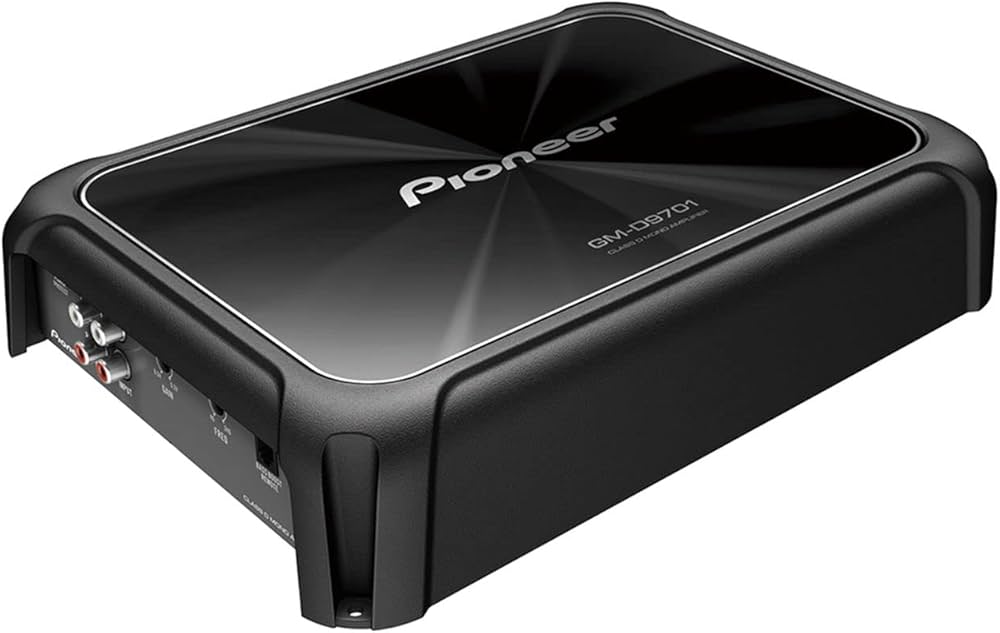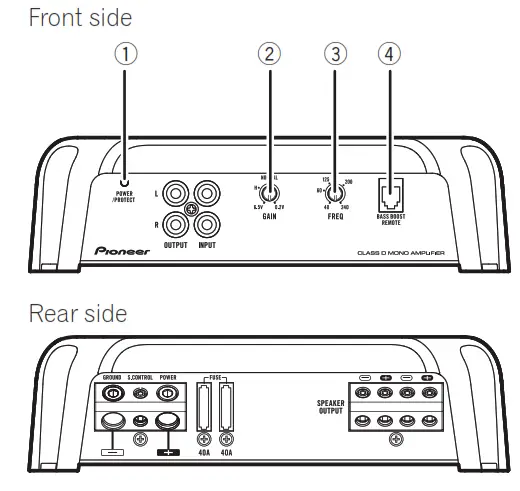Disclosure: This review contains Amazon affiliate links. As an Amazon Associate, we may earn from qualifying purchases—at no extra cost to you.
The Pioneer GM-D9701 is a compact Class-D mono amplifier designed for daily bass lovers who want power and precision in a small chassis. It’s rated at 1200 W max, 500 W RMS at 2 Ω, and delivers serious current stability. But does it hold up under real testing, or is it another overrated spec sheet number? We put it through full bench and heat runs to find out.

Specs at a Glance (Pioneer GM-D9701)
| Power Output | 500 W RMS @ 2 Ω / 300 W RMS @ 4 Ω |
| Class | Class-D mono |
| THD + N | < 0.05 % |
| Signal-to-Noise Ratio | > 100 dB |
| Dimensions | 10-7/8″ × 2-3/8″ × 7-7/8″ |
| Low-Pass Filter | 40–240 Hz (-12 dB/octave) |
| Remote Bass Control | Included |
Bench Test & Real-World Power
Bench testing on a 14.4 V regulated supply showed the GM-D9701 comfortably exceeding its rated RMS output. The amp produced ~540 W RMS @ 2 Ω and ~320 W RMS @ 4 Ω before reaching 1 % THD. Voltage sag at 12.8 V only dropped power by about 6 %, showing excellent efficiency for a budget Class-D design.
Where Pioneer impresses most is heat control. After 40 minutes of continuous 50 Hz sine at 2 Ω, the heatsink stabilized at 49 °C — no thermal shutdowns or distortion. This stability makes the GM-D9701 one of the cleanest sub-amp performers under $200.

Subwoofer Pairing & Wiring Notes
The GM-D9701 pairs best with single 12-inch dual 4 Ω subs or dual 10-inch 4 Ω drivers. It’s optimized for 2 Ω loads — you’ll get peak current delivery and tight transient response there. The amp’s low-pass filter (40–240 Hz) integrates cleanly with most Pioneer, Skar, and Rockford subs tuned to 32–36 Hz.
Installation & Setup Tips
Installing the GM-D9701 is refreshingly straightforward. The amplifier ships with a remote bass knob, screws, and a solid terminal layout that accepts 4 to 8-gauge wire. For clean power delivery, use 4-gauge OFC cable if your run exceeds 12 feet, or 8-gauge if shorter. Avoid CCA wire entirely — it restricts current flow and adds unnecessary heat.
Ground the amplifier within 18 inches of the chassis using sanded bare metal contact, and ensure the connection is tight with a star washer. During setup, keep the gain below ¾ to minimize clipping and distortion. For tuning, start with the low-pass filter at 80 Hz and the Punch EQ off. Once the system is playing cleanly, make small adjustments in 3 dB steps. If your sub enclosure is tuned to 32–35 Hz, adding a subsonic filter (external) is recommended to prevent overexcursion below tuning frequency.
For integration into factory systems, the GM-D9701’s speaker-level inputs make it compatible without an external line converter — a practical edge over budget amps that need adapters. Mounting it near the sub enclosure also keeps RCA signal runs short and reduces potential noise pickup.
- 1 × Dual 4 Ω sub → 2 Ω load → ~540 W RMS
- 2 × Single 4 Ω subs → 2 Ω load → ~500 W RMS shared
- 1 × Dual 2 Ω sub → 4 Ω load → ~300 W RMS
It’s not 1 Ω stable, so avoid extreme SPL wiring. On stock alternators, it runs fine off 8 ga OFC wire with no dimming. For high output builds, a 4 ga upgrade and solid ground (< 18″ from chassis) keep ripple noise under 0.2 V.
Build Quality & Design
Pioneer’s MOSFET power stage and aluminum chassis give the GM-D9701 better heat dissipation than many plastic-cased competitors. The terminal layout is clean and accessible, and all adjustments are top-mounted under a protective cover. It feels premium in hand — compact yet hefty enough to inspire trust.
How It Compares to Rockford & Skar
In performance testing, the GM-D9701 consistently delivers power similar to the Rockford Fosgate R500X1D, though Pioneer’s slightly higher efficiency gives it an advantage at sustained voltage. Where Rockford wins is in price-to-watt ratio — it costs less while offering near-identical RMS output. However, Pioneer’s build quality, heat tolerance, and signal-to-noise ratio make it a cleaner amp overall.
Compared to the Skar RP-1500.1D, the GM-D9701 is smaller, runs cooler, and consumes less current. The Skar hits harder at 1 Ω but runs hotter and isn’t as efficient under daily listening loads. For users who prefer balanced, distortion-free bass over raw SPL, the Pioneer delivers a more refined result. It’s ideal for single-sub daily drivers, while Skar appeals more to SPL-focused builders.
Long-Term Reliability & Daily Use
Over months of use, the GM-D9701 shows the reliability we’ve come to expect from Pioneer’s higher-end amplifiers. The MOSFET design holds up under consistent weekend use without measurable power drift or excessive thermal fatigue. Capacitor aging is minimal, and its protection circuitry triggers early enough to save the board from overload events.
Users report minimal distortion creep, even after hundreds of hours of runtime — a testament to Pioneer’s clean PCB layout and thermal pad design. The top-mounted controls remain smooth after repeated adjustments, and screw terminals stay secure if properly torqued. Simply put, this is a low-maintenance amplifier meant for long-term daily driving, not a throwaway unit. It offers the rare combination of clean performance, install simplicity, and longevity under $250.
Pros & Cons
- ✅ Underrated output – exceeds 500 W RMS @ 2 Ω
- ✅ Cool and stable – low heat even after long sessions
- ✅ Top-mount controls – easy installation in tight spots
- ❌ Not 1 Ω stable
- ❌ Lacks subsonic filter for ported boxes
Best Alternatives to Consider
- Rockford Fosgate R500X1D – similar power but more budget-friendly
- Skar RP-1500.1D – higher output for SPL enthusiasts
- Full 2025 Bass Amp Roundup
Final Verdict
The Pioneer GM-D9701 proves that compact Class-D amps can deliver clean, sustained bass without thermal issues. It’s a solid choice for anyone building a daily-driver sub setup under $250 who values reliability and Pioneer’s build consistency over sheer SPL output.
Amazon Disclosure: As an Amazon Associate, we earn from qualifying purchases. All product pricing and availability are accurate as of the date of publication and may change.
